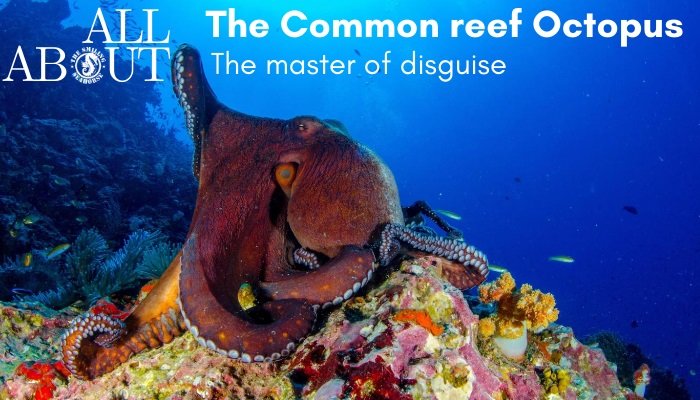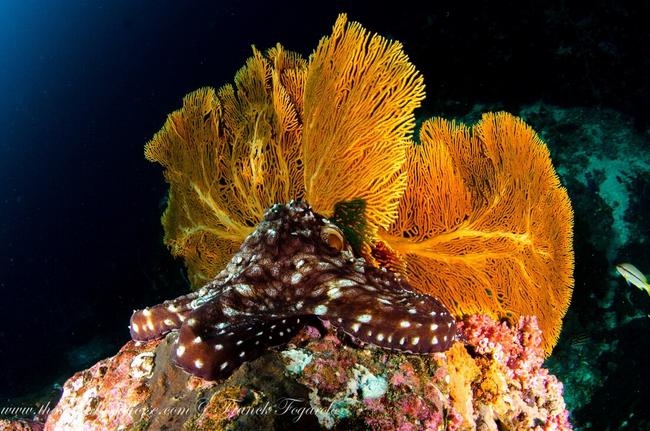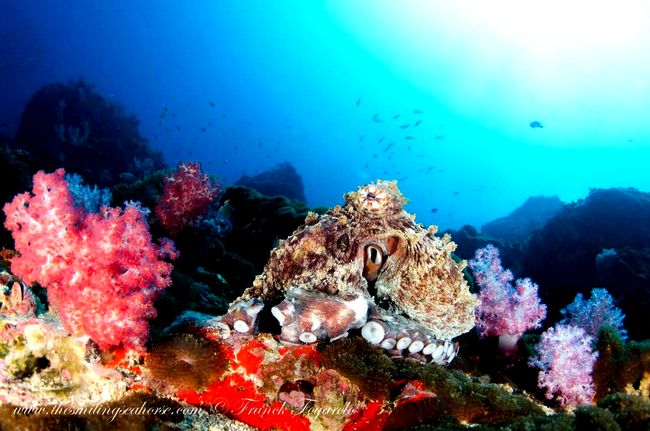A very popular subject of many marine biologists, the Octopus Vulgaris or common reef octopus, is a master of disguise...

The octopus is a mollusc belonging to the class of cephalopoda.
It’s arms can grow to a whopping 1m in length and its mantle as long as 25cm.
THE HABITAT
This type of octopus can be found in the tropical and temperate waters of the the Eastern Atlantic, Mediterranean sea, the Pacific ocean and the coast of Africa.
It prefers shallow rocky bottoms or coastal coral reef in depths above 200m. Octopi will find themselves a shelter where they can minimize exposure and stay safe but will come out, mostly at night, to hunt. They usually move by crawling along the sea floor where it can protect its belly. They are also known to swim using a type of jet mechanism found in its mantle cavity.
THE BEHAVIOR
Its favourite food are crabs and molluscs, although it will generally eat whatever it can catch. Using its beak, it is able to break the shell of any armoured morsel.
It can change colour to camouflage or to mirror its state of mind and mood. It has also been observed changing colour while sleeping which suggests that it is possibly capable of dreaming.
It uses gills as its respiratory system. It has 3 hearts : 1 main heart and 2 small ones that are each located next to a set of gills. It sends oxygenated blood from the gills to the main heart, which send blood to the body. Deoxygenated blood goes from the body back to the small branchial hearts which pump the blood across the gills to oxygenate it and then back to the main heart to begin a new cycle.

THE REPRODUCTION
Octopi are solitary creatures with short life spans. They spend most of their young life eating and growing until they reach sexual maturity. At this time, they will metabolize muscle mass to make sperm and eggs and search for a mate.
Mating can be very dangerous for the male. A female doesn’t often refuse a male’s advances but it is not uncommon for the female to change her mind and eat the male. To address this problem, males have a specially adapted mating arm that can deliver sperm into the female’s mantle cavity from a safe distance.
The female will lay between 100 000 to 500 000 eggs which she will very rarely leave unattended for her 4-5 month brooding. She will even stop eating to take care of them and will die shortly after they hatch.
A VERY SMART ANIMAL
Studies show that they are extremely clever and resourceful. They have a much more complex nervous system than other mammals and most of their 500 million neurons are found in their arms. The have been taught to navigate mazes, problem solve and recognize visual clues to find the best way to get to a reward. Don’t under estimate them !

MORE SEALIFE STORIES ON OUR BLOG |